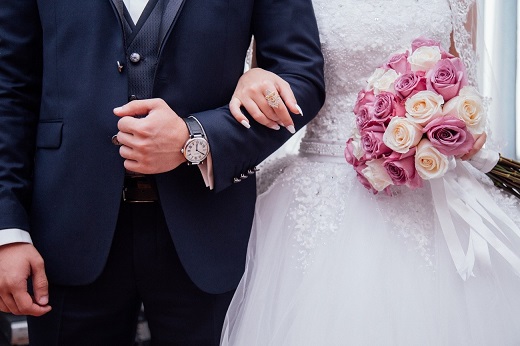
As I’ve written in various articles before, I usually teach piano, but on weekends, I work as a bridal musician.
This time, I thought I’d write an article about my other job as a bridal musician.
Weddings also have their seasons. From around mid-September, when it becomes cooler and more comfortable, to November, there are many weddings, making it a busy season for the bridal industry.
In addition to this autumn season, spring is another peak period, from around late March to May. Many people prefer these seasons to avoid the heat of summer or the cold of winter.
Of course, there are people who hold weddings outside of these seasons. However, in summer, there’s the risk of typhoons (though September can still have typhoons), and in winter, there might be concerns about snow.
For guests traveling from afar, transportation issues with flights or bullet trains can prevent them from attending. Spring and autumn are the seasons with the least such worries.
In this article, I’d like to discuss what a bridal musician does and other related topics.
■ 目次
What is a Bridal Musician?
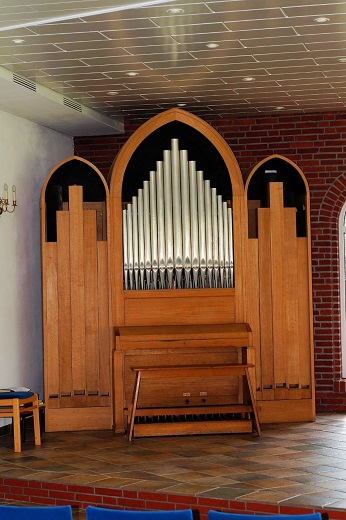
There are two types of bridal performances: “playing music at the wedding ceremony” and “playing music at the reception.” I do the former, so I will focus on that here.
Playing music at a wedding means performing to enhance moments such as the bride and groom’s entrance or exit.
The flow of a ceremony varies depending on the venue and the preferences of the couple, so it’s never exactly the same.
Weddings can be classified into three main types: “Christian weddings,” “civil ceremonies,” and “Shinto weddings.”
“Shinto weddings” are usually held at shrines, where traditional court music (gagaku) is often used. Instruments like the hichiriki and the sho are played. Since there aren’t many musicians who can play these instruments, recorded music may sometimes be used.
For “Christian weddings” and “civil ceremonies,” the typical setup includes a choir, an organist, and an officiant. The choir may consist of just one person, or it could have two or three members.
The standard arrangement is a choir and an organ, but other instruments may be added. These can include flutes, saxophones, trumpets, violins, cellos, and more.
The composition of musicians and instruments varies depending on the venue and the couple’s preferences, but the common factor is that the music is performed to match the flow of the ceremony.
The songs to be played are usually pre-determined by the venue, and requests are accommodated if there are any.
While the flow of the ceremony differs, both “Christian weddings” and “civil ceremonies” generally proceed as follows:
Groom’s Entrance
↓
Bride’s Entrance
↓
Exchange of Vows
↓
Ring Exchange
↓
Wedding Kiss
↓
Signing of Marriage Certificate
↓
Declaration of Marriage
↓
Bride and Groom’s Exit
For “Christian weddings,” additional elements such as Bible readings or singing hymns as a group are included. In “civil ceremonies,” the concept is to be free from formalities, so there are truly a variety of patterns.
While there may be moments without music, songs are generally assigned to specific parts of the ceremony, and sheet music is prepared. The performance begins at designated moments, and the musician monitors the progression to calculate the song’s length and stop playing at the appropriate time.
This ability to adjust the performance based on the ceremony’s progression is what sets bridal musicians apart from regular performances. When performing in public under normal circumstances, you simply play from start to finish. But as a bridal musician, finishing the song is not the end.
The performance must align with the movements of the bride and groom and the flow of the ceremony. It’s common to find that the piece you’ve played once isn’t long enough. In such cases, you need to find a way to extend it.
Musicians, including those in the choir or playing other instruments, decide beforehand where to repeat or adjust. However, when even that isn’t enough, the organist might have to extend the music solo.
Conversely, if the ceremony proceeds smoothly, the music may need to be stopped earlier than planned.
It’s not just about avoiding mistakes. Failing to extend or stop the music at the right moment is unacceptable.
The role of the bridal musician is to support the flow of the ceremony seamlessly and enhance it through music.
What Kind of Music Is Frequently Used?

Let’s go over some of the songs frequently used in ceremonies.
In the case of a “Christian-style” ceremony, classical music is commonly chosen.
Mendelssohn: “Wedding March”
Wagner: “Wedding March”
Pachelbel: “Canon”
Bach: “Air on the G String”
Bach: “Jesu, Joy of Man’s Desiring”
Schubert: “Ave Maria”
Handel: “Ombra Mai Fu”
Elgar: “Salut d’Amour”
Liszt: “Liebestraum No. 3”
Schumann: “Träumerei” etc.
Non-classical songs are also used.
“Amazing Grace”
“Can’t Take My Eyes Off You”
“Somewhere Over the Rainbow”
“You Raise Me Up” etc.
Disney songs are also sometimes chosen.
“A Whole New World”
“Someday My Prince Will Come”
“When You Wish Upon a Star” etc.
There are likely many more, but these seem to be the ones most often used.
Playing Styles Differ from the Piano
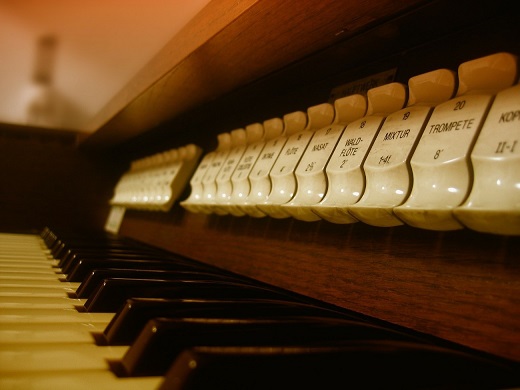
While pianos are often found in banquet halls, chapels rarely have pianos. The instruments vary by venue—some have organs, while others use keyboards.
Although each piano has its own personality and slight variations, compared to a keyboard, the differences are negligible. Keyboards, on the other hand, vary significantly depending on the model.
Some keyboards have touch sensitivity similar to a piano, while others do not respond to touch at all. Conversely, there are also keyboards that are overly sensitive.
Keyboards allow you to select and play various tones, unlike the piano, but you need to adjust your playing style slightly for each tone. For example, while a piano uses pedals to sustain sound, organs do not have pedals. Some keyboards also lack pedals.
In such cases, playing directly from piano sheet music can sound unnatural. It’s necessary to rearrange the music to suit the specific instrument or tone.
For instance, if you’re playing on a keyboard without a pedal and encounter a bass note that you’d like to sustain, the note might break off due to a leap in the music. While a piano pedal could sustain the note, you’d need to adjust the left-hand part on the keyboard so the bass can be sustained without interruption. This often involves changing the accompaniment style to keep the notes within an octave range.
In addition, if the tone is not touch-sensitive like a piano, you need to pay attention to the thickness of the sound.
With a piano, you can play multiple notes simultaneously, then transition to a single note, and back to multiple notes without it sounding strange. This is because you can adjust the dynamics with touch.
However, with non-touch-sensitive tones or organ tones, such transitions can result in uneven dynamics—loud sounds suddenly becoming soft and then loud again.
To avoid this, it’s important not to suddenly increase or decrease the number of notes played.
When you cannot control volume through touch, you can create a crescendo by gradually lengthening note values or increasing the number of notes. For a decrescendo, you do the opposite. This requires playing techniques and adjustments that differ from those for the piano.
You might think this all sounds negative, but there are advantages too!
For instance, with a piano, the sound naturally decays even if you hold down the keys, eventually disappearing. However, with an organ or keyboard, as long as you hold the key down, the sound continues to play (though this depends on the model and tone).
On a piano, you need to strike the same note again to replay it, but with an organ or keyboard, the note will continue as long as you hold it down (though there are cases where you might need to strike it again).
Adjusting the Music’s Length to Match Movements
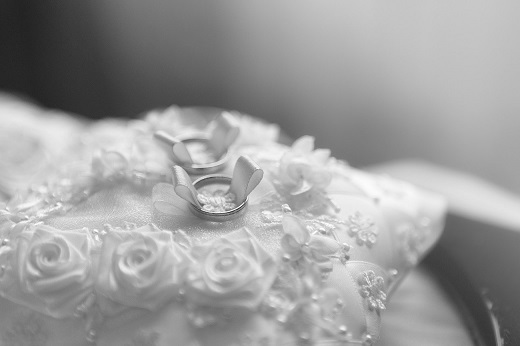
The approximate length of a piece of music is usually pre-determined, but walking speeds vary from person to person, and the presence or absence of a veil-down ceremony can also affect the timing.
It is common to have a child carry the rings, but there are also cases where the couple’s pet dog carries the rings. In such situations, unexpected delays can occur when the pet doesn’t move forward as planned.
When such mishaps happen, it’s essential to stay calm and handle them appropriately.
If it’s difficult to predict when the music should stop, it can be challenging to perform with other musicians or a choir. In such cases, after performing the pre-arranged length of the piece together, the organist usually bridges the gap with a solo.
An organist must not only be able to play the entire piece but also be prepared to end the music at any point. It’s generally safer to plan to finish at intervals of about every two measures (or every four measures at most).
Some sections are harder to stop at than others. If it’s unclear what might happen during the ceremony, you can avoid playing those tricky parts. Instead, you should identify sections where you can naturally transition and bring the piece to a close without it feeling awkward.
Additionally, being able to play chords that fit the piece’s structure allows you to conclude the music at any time.
If you play the melody, it becomes harder to stop mid-piece. However, with chords, you can quickly create a cadence and bring the piece to a smooth end. When you feel it’s time to stop, switching to chords at an appropriate moment ensures a natural finish without abruptness.
How to End the Performance Midway
This type of sheet music is also available for purchase. This book contains many pieces suitable for bridal settings, and it also includes the order of performance. It’s a recommended piece of sheet music as it provides a reference for adjusting the size of the performance.
The method of stopping may vary depending on the performer, but I will describe how I stop pieces.
Let’s use the frequently performed Schubert’s Ave Maria as an example.
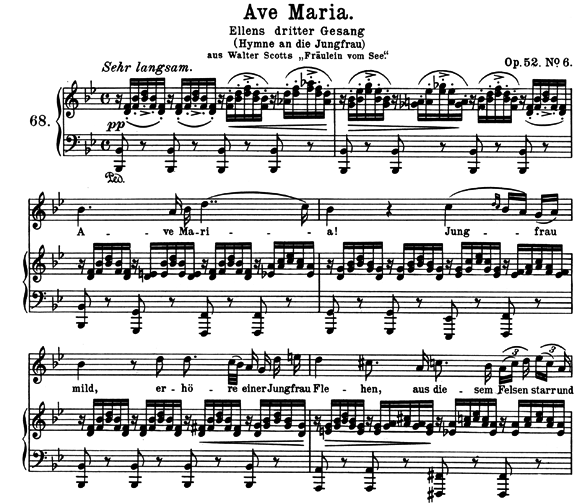
This piece has three verses. Depending on the tempo of the performance, playing the entire piece takes about five minutes. Therefore, when performed at a ceremony, a shortened version, such as playing only the first verse, is usually used.
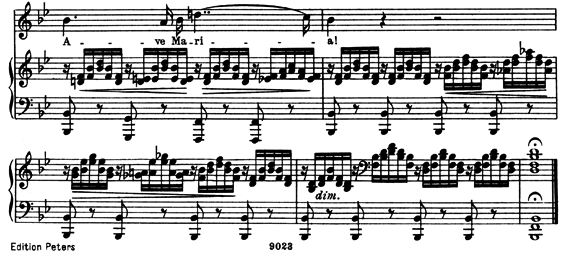
After finishing the first verse, many versions are arranged to proceed directly to the final coda. This is what I think is the basic size of the piece. (The size may vary depending on factors such as the length of the aisle, whether there are stairs, or whether the piece is used during the bride’s entrance or during the ring exchange.)
While the ceremony may progress smoothly, allowing for the basic size to be used, in most cases, the size is not sufficient. (There are rare instances where the size may need to be shortened as well.)
When the size needs to be extended, it usually involves continuing with the organ alone. Therefore, simply playing the accompaniment as written in the sheet music won’t suffice. If the vocal part finishes, the melody will disappear, so the melody part must also be played on the organ.
As you can see from the sheet music, the accompaniment is played with both hands. Thus, it is impossible to cover the melody while playing the accompaniment as written. Therefore, I modify the way I play: I play the melody with my right hand and the accompaniment with my left hand.
First, I practice playing through the piece using this method.
Once I can do that, I practice stopping at any point, as mentioned earlier. It’s a good idea to practice stopping every two measures (or every four measures at most).

This sheet music shows the opening part of the piece. You can play the melody up to “Ave Maria!” and then connect to the coda to stop. Alternatively, you can play up to the next part, “Jungfrau mild,” and connect to the coda to stop, just like before.
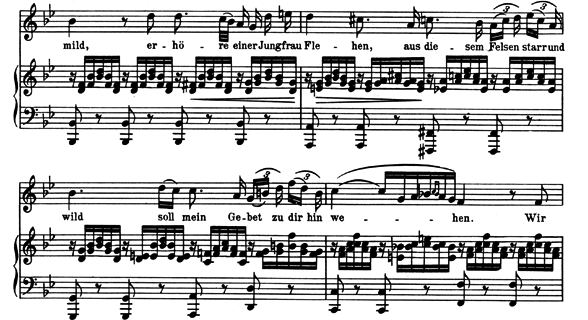
After “mild,” it feels unnatural to stop midway, so I play up to “we hen.” If I need to stop soon after playing “we hen,” I change the notes from F to Es to lead into the final “Ave Maria” before the coda. If I proceed past “Wir,” it becomes difficult to stop again, so I only proceed if it seems the performance will take longer.
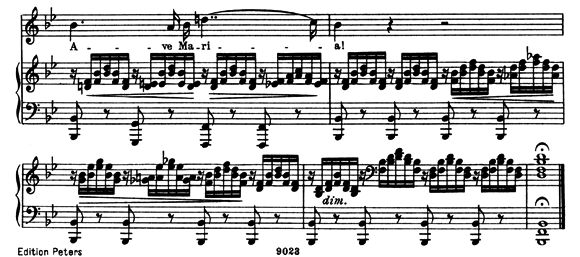 (Video 4:58–)
(Video 4:58–)This coda is very convenient.
Even the coda can be stopped midway. You can stop at the second beat of the second measure in the first line by playing the chord there.
After that, since the notes ascend, it becomes impossible to stop immediately. However, you can stop at the chord in the third beat of the second line.
From here, the notes descend significantly, so I personally try to avoid using this part. However, it is possible to stop at the chord at the beginning of the second measure of the second line.
In this way, I identify possible stopping points and prepare to end the piece there. If the melody returns when it’s almost time to stop, it might become challenging to end at a good moment. In such cases, I play chords to connect the parts.
The chords look like this:

You can stop at the points indicated by the arrows. (In the third measure, change the chords to those inside the parentheses. If playing the section a second time, avoid playing all four notes at once; instead, play them slightly offset, arpeggiate the left hand, or vary the rhythm to avoid repetition.)
There may be pieces where it’s challenging to connect smoothly to the coda or find a natural transition point. In such cases, I prepare to stop the melody even when playing it.
To end the piece, I modify the melody slightly to lead into a cadence or create a cadenza to make the ending sound natural for that particular spot.
What is Required of a Bridal Performer
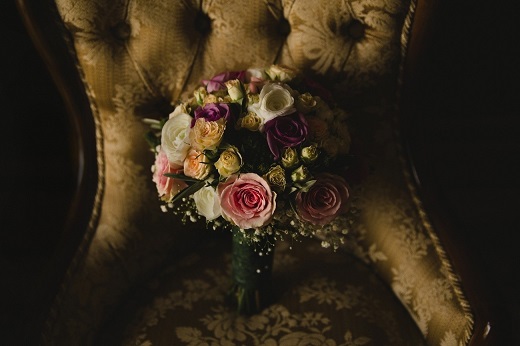
Of course, playing without mistakes and paying close attention to the surroundings while performing are essential. However, I believe it is also important to have the mindset of enhancing and creating a memorable atmosphere for the wedding with music.
The work of a bridal performer is never the same, so it can be challenging, but it is also a highly rewarding job.
You don’t necessarily need to have graduated from a music conservatory to qualify as a performer, but a certain level of playing skill is required. If you search for bridal performer job openings, you’ll likely find many opportunities. If you’re interested, I encourage you to apply and take an audition.
Before starting work, there’s usually a period during which you’ll receive lessons or training. As long as you learn diligently during that time, you’ll be fine.
This time, I’ve written about bridal performers. What did you think? I’d be delighted if this article sparked your interest in becoming a bridal performer.
Summary
◆ Perform according to the flow of the ceremony◆ Classical music is often used
◆ It’s necessary to adjust your playing style depending on the instrument and tone color
◆ Practice so that you can stop playing at any point
◆ Enhancing and creating a memorable atmosphere for the wedding with music is the job of a bridal performer
- IMSLP (Sheet Music Link)
This article was created using this sheet music. It is public domain sheet music published by the Peters Edition.



